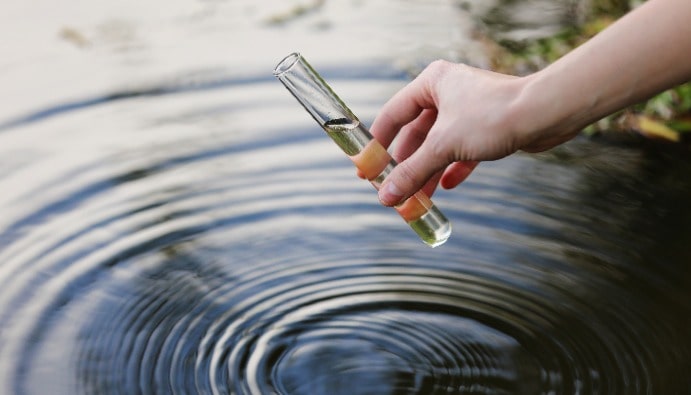
BLOG
KATEGORİDEKİ DİĞER YAZILAR

Water for human consumption, water for use, pool water, seawater and hemodialysis water should be tested and analyzed and reported periodically in many test parameters in general.
As urban, industrial and agricultural wastewater enters water, biological and chemical contaminants, including heavy metals, also enter water bodies. Although some of these metals are essential as micronutrients, their high concentrations in the food chain can cause toxicity and environmental impacts and endanger aquatic ecosystems and their users. Therefore, water samples were analyzed for Aluminum (Al), Antimony (Sb), Arsenic (As), Copper (Cu), Barium (Ba), Mercury (Hg), Zinc (Zn), Silver (Ag), Cadmium (Cd), Cobalt (Co), Chromium (Cr), Lead (Pb), Manganese (Mn), Molybdenum (Mo), Nickel (Ni), Selenium (Se), Vanadium (V), Boron (B), Iron (Fe), Phosphorus (P), Tin (Sn), Calcium (Ca), Lithium (Li), Magnesium (Mg), Potassium (K), Sodium (Na), Strontium (Sr) are tested.
Nitrate and nitrite are naturally occurring ions that are part of the nitrogen cycle. Nitrate ion (NO3 -) is the stable combined nitrogen for oxygenated systems. Although chemically non-reactive, it can be reduced by microbial action. The nitrite ion (NO2 -) contains nitrogen in a relatively unstable oxidation state. Chemical and biological processes can reduce nitrite to various compounds or oxidize it to nitrate. The concentration of nitrate in surface water is normally low (0-18 mg/l), but can reach high levels as a result of contamination by agricultural runoff, waste discharge streams, or human or animal waste.
Alkalinity is a chemical measure of a water's ability to neutralize acids. Alkalinity is also a measure of a water's buffering capacity, or its ability to resist changes in pH upon the addition of acids or bases. The alkalinity of natural waters is mainly due to the presence of weak acid salts, but strong bases can also contribute to industrial waters.
The presence of free chlorine in drinking water as chlorine residual, free chlorine residual, residual chlorine indicates: it may have been added to the water to inactivate bacteria and some viruses, or it may have been added to protect the water from contamination during storage. The presence of free chlorine in drinking water is associated with the absence of most disease-causing organisms and is therefore a measure of the water's potability.
Chlorine in the form of chloride (Cl-) ion is one of the major inorganic anions in water and wastewater. Chloride concentration in wastewater is higher than in raw water. High concentrations of chlorine can be found along the seashore due to seepage of salt water into the sewage system. It can also be increased by industrial processing. In drinking water, the salty taste produced by the chloride concentration is variable and depends on the chemical composition of the water. High chlorine content can damage growing plants as well as metal pipes and structures.
Salinity is a measure of the amount of salts dissolved in water. It is usually expressed in parts per thousand (ppt) or percent (%). The salinity value of fresh water from rivers is 0.5 ppt or less. Within the estuary, salinity levels are called oligohaline (0.5-5.0 ppt), mesohaline (5.0-18.0 ppt) or polyhaline (18.0-30.0 ppt). Near the connection with the open sea, estuarine waters can be euhaline, with salinity levels greater than 30.0 ppt, which is the same as the ocean.
Salinity varies from place to place in the oceans, but the relative proportions of the largest dissolved components remain almost constant. Although there are smaller amounts of other ions in seawater (e.g. K+, Mg2+, SO4 2- ), sodium (Na+) and chloride (Cl-) ions represent about 91% of all seawater ions. Fresh water has much lower salt ions.
Fluoride is a substance used in the artificial fluoridation of water supplies, considered essential for healthy teeth and bone development. Fluoride is also added to water supplies through the production of phosphate-containing fertilizers and aluminum processing industries. Consumption of high levels of fluoride in drinking water can cause dental and skeletal fluorosis, as well as acute stomach problems and kidney failure. Therefore, the fluoride level in water supplies is a necessary parameter to control.
Nanolab Laboratories Group continues to provide services within the scope of Chemical Analysis in Water Sample. We also provide services in Physical Analysis of Water Samples.
Contact us for more information.
You can follow us on LinkedIn for up-to-date news and posts about our services.
Follow our Instagram account to be informed about our latest blog posts.